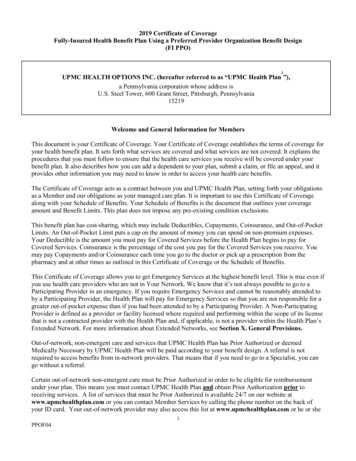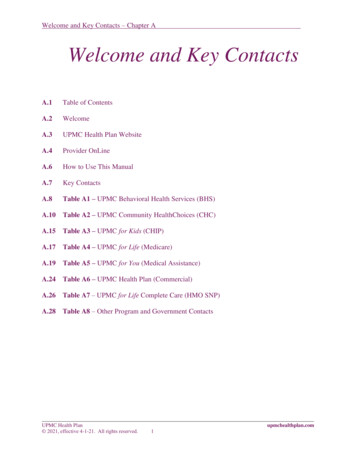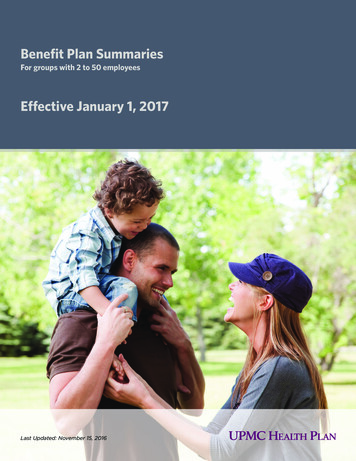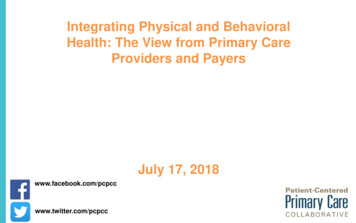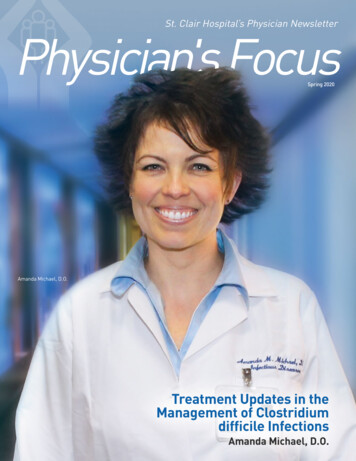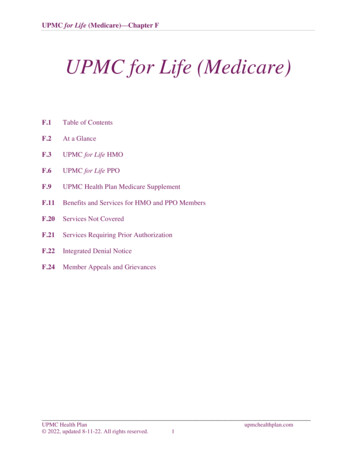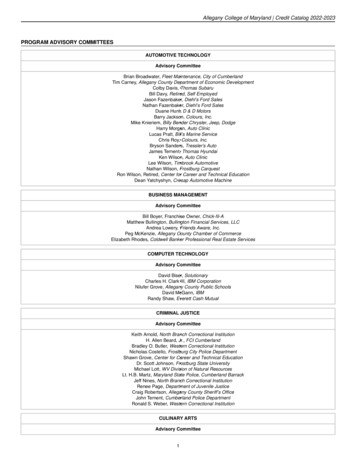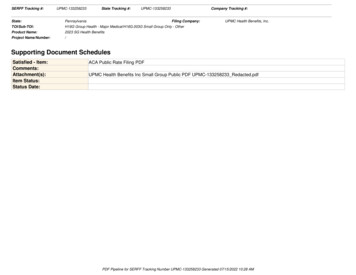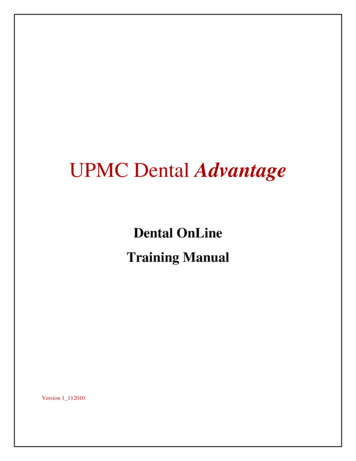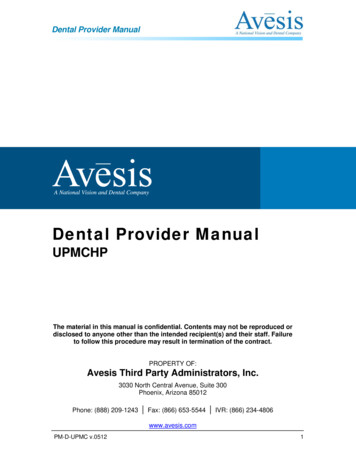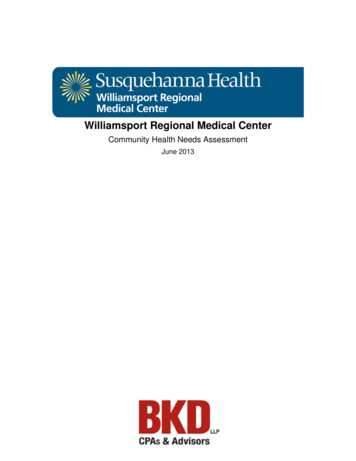
Transcription
Williamsport Regional Medical CenterCommunity Health Needs AssessmentJune 2013
Williamsport Regional Medical CenterCommunity Health Needs AssessmentJune 2013ContentsConsultant’s Report . 1Introduction . 2Summary of Community Health Needs Assessment . 3General Description of Hospital . 3Community Served by the Hospital . 5Defined Community . 5Community Details . 7Identification and Description of Geographical Community . 7Community Population and Demographics . 7Socioeconomic Characteristics of the Community . 13Income and Employment . 13Poverty. 15Uninsured . 16Education . 18Health Status of the Community . 19Leading Causes of Death . 20Health Outcomes and Factors . 22Lycoming County . 23Health Care Resources . 26Hospitals and Health Centers . 28Hospital Market Share . 29Other Health Care Facilities and Providers . 29Estimated Demand for Physician Office Visits and Hospital Services . 30Estimated Demand for Physician Services. 34Recommendations . 36
Williamsport Regional Medical CenterCommunity Health Needs AssessmentJune 2013Key Informant Interviews. 36Methodology. 36Key Informant Profiles . 37Key Informant Interview Results . 37Key Findings . 41Community Health Input Questionnaire. 42Methodology. 42Community Health Input Questionnaire. 42Community Health Input Results . 42Prioritization of Identified Health Needs . 44Considerations for Meeting Identified Health Needs . 48Obesity. 48Affordable Healthcare . 48Diseases of the Heart . 49Diabetes . 51Cancer . 51Mental and Emotional Well-Being . 53Health Issues of Uninsured Persons, Low-Income Personsand Minority Groups. 54AppendicesAcknowledgements . 55Project Steering Committee . 55Key Informant . 55Community Health Input Questionnaire. 56Key Informant Interview Protocol . 57Community Health Input Questionnaire Detail Results . 62Sources . 93
Consultant’s ReportMs. Jan FisherExecutive Vice President/Chief Operating OfficerSusquehanna HealthWilliamsport Regional Medical CenterWilliamsport, Pennsylvania 17701On behalf of Williamsport Regional Medical Center, (WRMC) we have assisted in conducting aCommunity Health Needs Assessment (CHNA) consistent with the scope of services outlined in ourengagement letter dated August 9, 2012. The purpose of our engagement was to assist the System inmeeting the requirements of Internal Revenue Code §501(r)(3). We relied on the guidance contained inIRS Notice 2011-52 when preparing your report. We also relied on certain information provided byWRMC, specifically certain utilization data and existing community health care resources.Based upon the assessment procedures performed, it appears WRMC is in compliance with the provisionsof §501(r)(3). Please note that, we were not engaged to, and did not, conduct an examination, theobjective of which would be the expression of an opinion on compliance with the specified requirements.Accordingly, we do not express such an opinion.We used and relied upon information furnished by the Organization, its employees and representativesand on information available from generally recognized public sources. We are not responsible for theaccuracy and completeness of the information and are not responsible to investigate or verify it.These findings and recommendations are based on the facts as stated and existing laws and regulations asof the date of this report. Our assessment could change as a result of changes in the applicable laws andregulations. We are under no obligation to update this report if such changes occur. Regulatoryauthorities may interpret circumstances differently than we do. Our services do not include interpretationof legal matters.June 21, 2013
Community Health Needs Assessment 2013IntroductionIRC Section 501(r) requires health care organizations to assess the health needs of their communities andadopt implementation strategies to address identified needs. Per IRC Section 501(r), a byproduct of theAffordable Care Act, to comply with federal tax-exemption requirements, a tax-exempt hospital facilitymust: Conduct a community health needs assessment every three years. Adopt an implementation strategy to meet the community health needs identified through theassessment. Report how it is addressing the needs identified in the community health needs assessment and adescription of needs that are not being addressed with the reasons why such needs are not beingaddressed.The community health needs assessment must take into account input from persons who represent thebroad interest of the community served by the hospital facility, including those with special knowledge ofor expertise in public health. The hospital facility must make the community health needs assessmentwidely available to the public.This community health needs assessment, which also describes the process, is intended to documentWilliamsport Regional Medical Center’s, compliance with IRC Section 501(r). Health needs of thecommunity have been identified and prioritized so that Williamsport Regional Medical Center, (Hospital)may adopt an implementation strategy to address specific needs of the community.The process involved: Collection and analysis of a large range of data, including demographic, socioeconomic andhealth statistics, health care resources and patient use rates. Interviews with key informants who represent a) broad interests of the community, b) populationsof need or c) persons with specialized knowledge in public health. Circulation of a Community Health Input Questionnaire that gathered a wide range ofinformation which was widely distributed to members of the community. Collaboration of the three hospital, Williamsport Regional Medical Center, Divine ProvidenceHospital and Muncy Valley Hospital to prioritize health need results.This document is a summary of all the available evidence collected during the initial cycle of communityhealth needs assessments required by the IRS. It will serve as a compliance document as well as aresource until the next assessment cycle.Both the process and document serve as the basis for prioritizing the community’s health needs and willaid in planning to meet those needs.2
Community Health Needs Assessment 2013Summary of Community Health Needs AssessmentThe Hospital engaged BKD, LLP to conduct a formal community health needs assessment. BKD, LLP isone of the largest CPA and advisory firms in the United States, with approximately 2,000 partners andemployees in 30 offices. BKD serves more than 900 hospitals and health care systems across the country.The community health needs assessment was conducted from December 2012 through April 2013.Based on current literature and other guidance from the treasury and the IRS, the following steps wereconducted as part of Hospital’s community health needs assessment: The “community” served by the Hospital was defined by Hospital administration. This process isfurther described in Community Served by the Hospital. Population demographics and socioeconomic characteristics of the community were gathered andreported utilizing information from various third parties (see references in Appendices). Thehealth status of the community was then reviewed. Information on the leading causes of deathand morbidity information was analyzed in conjunction with health outcomes and factors reportedfor the community by CountyHealthrankings.org. Health factors with significant opportunity forimprovement were noted. An inventory of health care facilities and resources was prepared and a demand for physician andhospital services was estimated. Both were evaluated for unmet needs. Community input was provided through key informant interviews of 25 stakeholders and acommunity health input questionnaire was widely distributed. The Community Health InputQuestionnaire was completed by 474 individuals. Results and findings are described in the KeyInformant and Community Health Input Questionnaire sections of this report. Information gathered in the above steps was analyzed and reviewed to identify health issues ofuninsured persons, low-income persons and minority groups and the community as a whole.Health needs were ranked utilizing a weighting method that considers 1) the ability of theHospital to impact change, 2) the size of the problem, 3) the seriousness of the problem and 4) theprevalence of common themes.Health needs were then prioritized taking into account the perceived degree of influence theHospital has to impact the need and the health needs impact on the overall health of thecommunity. Information gaps were identified during the prioritization process and are alsoreported. Recommendations based on this assessment have been communicated to Hospital management.General Description of HospitalIn July 1994, an alliance was formed among three area hospitals, signaling the beginning of a new era inhealthcare for the region. This alliance, Susquehanna Health, brought together Williamsport RegionalMedical Center, Divine Providence Hospital and Muncy Valley Hospital, along with all their subsidiaries,into one fully integrated healthcare system that provides healthcare to residents in the region and hasreceived national recognition for its healthcare leadership.3
Community Health Needs Assessment 2013In 1998, Susquehanna Health faced a new challenge of how to respond to the continuing decrease indemand for inpatient services and the increasing need for outpatient services. The decision was made tocreate a center for inpatient services at Williamsport Regional Medical Center, the Hospital with thehighest number of licensed beds, and a center for outpatient services, including same day surgery, atDivine Providence Hospital, the hospital more centrally located with the easiest access and mostconvenient parking. This move enabled Susquehanna Health to continue to serve patients while, at thesame time, helping to further reduce the cost of healthcare delivery.Laurel Health System—including Soldiers Sailors Memorial Hospital, The Green Home and otherservices—became part of Susquehanna Health in the fall of 2012. This partnership created an expandedhealthcare delivery system that benefits the entire Tioga-Lycoming region.Located in central Pennsylvania, Susquehanna Health is made up of these three hospitals, plus Soldiers Sailors Memorial Hospital in Wellsboro, Pennsylvania, with a total of 332 licensed acute and 259 longterm care beds, along with two skilled nursing units, home care division, physician services andambulance service. The system’s emergency departments have a total of approximately 56,000 visitseach year and its maternity units welcome 1,500 babies annually.In 1873, upon petition by members of the Lycoming County Medical Society and 23 leading citizens ofthe community, the Lycoming County Court granted a Charter establishing Williamsport RegionalMedical Center. A three-story brick building was purchased, and the first hospital in Williamsport, PAopened its doors around April 1, 1878. A new facility was built that was opened in 1891. Over 100 yearslater, the main building of the Hospital is still located on this site and is today Williamsport RegionalMedical Center campus of Susquehanna Health.At Williamsport Regional Medical Center, the rehabilitation and physical medicine center was establishedin 1961. The tremendous success of the center led to the current five-story Rehabilitation Center whichopened in 1970. During the 1960s, the Hospital created a mental health unit and initiated the firstintensive care unit in central Pennsylvania. In medicine, advances were being made in treatment of heartpatients, and in the early 1970s the hospital established a Cardiopulmonary Department that is thefoundation for the system’s cardiac surgery program today. As more and more physicians began tospecialize in various areas of medicine, this created a shortage of family practitioners. To train a newgeneration of skilled family practice physicians, Williamsport Regional Medical Center, in 1972,established the Family Practice Residency Program and became the first hospital in the northern half ofthe state to organize such a program. The Family Practice Residency Program continues to provideskilled family practitioners, many of whom locate in the region and provide medical support to ruralcommunities.At the end of 1997, the two city emergency departments, located less than three miles apart, wereconsolidated to create a center of excellence for emergency services at Williamsport Regional MedicalCenter. The consolidation of the two city emergency departments allowed the system to center the city’semergency services in one location and align them with other critical care services that are already on thatcampus.4
Community Health Needs Assessment 2013As mentioned previously in the introduction, the three hospitals located in Lycoming County,Williamsport Regional Medical Center, Divine Providence Hospital, and Muncy Valley Hospitalcollaborated together for the purpose of the Community Health Needs Assessment reports. Decisions forthe three hospitals are made at a system level. The defined community, described later in the report, is thesame for all three hospitals. Hence the responses from the community health input questionnaire as wellas the key informant interviews were used for each Hospital’s report. Soldiers & Sailors MemorialHospital has a separate defined community from the other three hospitals in the health system. Hence, thereport for Soldiers & Sailors Memorial Hospital is independent, with a separate community health inputquestionnaire and key informant interviews.Community Served by the HospitalThe Hospital is located in the city of Williamsport, Pennsylvania. Williamsport is an approximately onehundred seventy-five mile drive northeast from Philadelphia, Pennsylvania. Williamsport and thesurrounding geographic area are not close to any major metropolitan area. Williamsport is accessible by astate highway and other secondary roads.Defined CommunityA community is defined as the geographic area from which a significant number of the patients utilizinghospital services reside. While the community health needs assessment considers other types of healthcare providers, the utilization of Hospital services provides the clearest definition of the community. Thecriteria established to define the community is as follows: A zip code area must represent two percent or more of the Hospital’s total discharges and/oroutpatient visits. The Hospital’s market share in the zip code area must be greater than or equal to 20 percent. The area is contiguous to the geographical area encompassing the Hospital.Based on the patient origin of acute care discharges from July 1, 2011, through June 30, 2012,management has identified the community to be the entire county of Lycoming, which is comprised of thezip codes listed in Exhibit 1. Zip codes 17723, 17727 and 17742 are rural communities with lowpopulations, hence were excluded from Exhibits 1 – 5 of this report. For purposes of geographicalillustration, they are included. Due to the collaboration of the three Lycoming County hospitals and thedefined community being the same for all three, all of the exhibits will be equivalent in the CommunityHealth Needs Assessment reports for Divine Providence Hospital and Muncy Valley Hospital. Exhibit 1presents the Hospital’s patient origin and charges for each of the zip code areas in its community.Following is a detailed map of the Hospital’s geographical location and the footprint of the communityidentified in Exhibit 1. The map displays the Hospital’s geographic relationship to surrounding counties,significant roads and highways, and identifies the zip codes that make up the Hospital’s community.5
Community Health Needs Assessment 2013When specific information is not available for zip codes, the community health needs assessment relies oninformation for the specific county. The geographic area of the defined community is Lycoming County.The community health needs assessment utilizes the county when corresponding information is morereadily available.Exhibit 1Susquehanna Health - Williamsport Regional Medical CenterSummary of Inpatient Discharges by Zip CodeFY2012PercentZip an StationHughesvilleJersey t RunUnityvilleWatervilleAll OtherTotalof 100.0%12,156100.0%DischargesSource: Susquehanna Health6
Community Health Needs Assessment 2013Community DetailsIdentification and Description of Geographical CommunityThe following map geographically illustrates the Hospital’s location and community by showing thecommunity zip codes shaded. The community’s population is defined as the entire county of LycomingCounty.Community Population and DemographicsThe U.S. Bureau of Census has compiled population and demographic data based on the 2010 census.The Nielsen Company, a firm specializing in the analysis of demographic data, has extrapolated this databy zip code to estimate population trends from 2013 through 2018.7
Community Health Needs Assessment 2013Exhibit 2 illustrates that the overall population is projected to increase slightly over the five-year periodfrom 117,179 to 119,114. In line with the overall numbers, the age category that utilizes health careservices the most, 65 years and over, is projected to increase from 20,428 to 23,207. The projectedchanges to the composition of the total community, between male and female, are projected to remainapproximately the same over the five-year period.Exhibit 2Susquehanna Health - Williamsport Regional Medical CenterEstimated 2013 Population and Projected 2018 PopulationZip an StationHughesvilleJersey t RunUnityvilleWatervillePROVIDER SERVICE 7763177711777417776WilliamsportWilliamsportCogan StationHughesvilleJersey t RunUnityvilleWatervillePROVIDER SERVICE AREAUnder18 years18-44years45-64years65 yearsand 2,5082,262786992824324,018Estimated 2013 231Projected 2018 ce: The Nielsen Company8
Community Health Needs Assessment 2013Exhibit 2.1 provides the percent difference for each zip code from estimated 2013 to projected 2018 aswell as the ability to compare the percent difference to the state of Pennsylvania and the United States forcomparison purposes. Exhibit 2.1 illustrates that the overall population is projected to increase by 1.7percent over the five-year period which is higher than the projected increase for Pennsylvania at 1.0percent and lower than the United States increase of 3.3 percent. Montgomery and Montoursville zipcodes are projecting large increases overall in comparison to the rest of the county, especially for agegroup 65 years and over. Note that the age category that utilizes health care services the most, 65 yearsand over, is projected to increase overall by 13.6 percent. This increase in the 65 year and over categorywill have a dramatic impact on both the amount and type of services required by the community.Exhibit 2.1Susquehanna Health - Williamsport Regional Medical CenterEstimated 2013 Population vs. Projected 2018 Population Percent DifferenceZip CodeCityUnder18-4445-6465 years18 yearsyearsyearsand overTotalMaleFemalePercent ogan StationHughesvilleJersey t RunUnityvilleWatervillePROVIDER SERVICE nsylvania 2013 Estimated lvania 2018 Projected T DIFFERENCE-0.9%-0.7%-2.4%12.8%1.0%1.0%0.9%U.S. 2013 Estimated ,042U.S. 2018 Projected ,322PERCENT DIFFERENCE2.0%0.5%1.5%16.3%3.3%3.3%3.3%Source: The Nielsen Company9
Community Health Needs Assessment 2013The following is an analysis of the age distribution of the population for the community. The analysis isprovided by zip code and provides a comparison to Pennsylvania and the United States.Exhibit 2.2Susquehanna Health - Williamsport Regional Medical CenterEstimated 2013 Population vs. Projected 2018 Population with Percent TotalsZip CodeCityUnder18-4445-6465 years18 yearsyearsyearsand overTotalMaleFemaleEstimated 2013 ogan StationHughesvilleJersey t 49.1%16.6%23.6%33.6%26.3%100.0%51.0%49.0%TOTAL PROVIDER SERVICE 3%27.5%100.0%50.6%49.4%TOTAL PROVIDER SERVICE AREA20.4%33.6%26.5%19.5%100.0%48.9%51.1%ESTIMATED 201320.5%34.0%28.1%17.4%100.0%48.8%51.3%PROJECTED 2018 SYLVANIA 201323.7%35.9%26.4%13.9%100.0%49.2%50.8%UNITED STATES 201323.4%35.0%25.9%15.7%100.0%49.2%50.8%Projected 2018 PopulationWilliamsportWilliamsportCogan StationHughesvilleJersey t RunUnityvilleWatervilleSource: The Nielsen Company10
Community Health Needs Assessment 2013Very similar to the 13.6 percent growth seen in the overall number of people in the 65 year and overcategory in Exhibit 2.1, Exhibit 2.2 indicates that as a percent of total population for the community, the65 years and over category will be 19.5 percent of the total population in 2018 compared to 17.4percent in 2013. Lairdsville and Cammal zip codes are showing the highest increases for ages 65 andover with increases of 6.5% and 5.6%, respectively. The majority age group, ages 18-44, even with theincrease in the age group 65 and over increase, remains mostly unchanged over the five-year periodlowering just slightly from 33.9 percent to 33.6.While the relative age of the community population can impact community health needs, so can theethnicity and race of a population. Exhibit 3 shows the population of the community by ethnicity byillustratin
At Williamsport Regional Medical Center, the rehabilitation and physical medicine center was established in 1961. The tremendous success of the center led to the current five-story Rehabilitation Center which opened in 1970.
